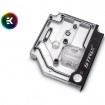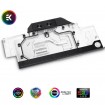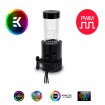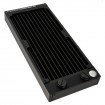I am looking for advice on the best way to setup my first ever custom loop. I have a Corsair H100i V2 Extreme AIO currently.
Case: Corsair Obsidian 500D (non-RGB)
Motherboard: ASUS ROG STRIX X470-F
CPU: Ryzen 2700X
GPU: Inno3D GTX1080ti X3
PSU: Corsair RM650i
After taking a look at the EKWB configurator I have decided to go with a Motherboard Block, GPU Block, and a Pump/Res Combo all of which I picked up in the recent sale. I went for a GPU block as I’d like to use the vertical GPU mount and the GPU would be starved of cooling as it would be too close to the tempered glass side panel.
My basket at Overclockers UK:
I am planning to start with a loop based on flexible tubing and compression fittings. I plan on going with a dual radiator setup with a 240mm at the top and a 360mm at the front, using the following radiators and backplate:
My basket at Overclockers UK:
I’m doing this as a learning experience and not as an adventure in massive overclocking. I am looking at EK Nickel 10/13mm Compression fittings with 3m of 9.5mm/12.7mm Duraclear tubing. I am relatively happy with ordering the usual other bits such as PWM splitters etc..
Question #1
Is it madness to use my existing Corsair LL120 fans despite their relatively low Static Pressure? I have six already with a single Commander Pro and 6-way RGB hub. I also have a spare RGB hub and two Lighting Node Pro’s.
Question #2
Secondly in what order should I run the loop? After researching and watching too much JayZTwoCents, his advice seems to suggest says the order shouldn’t matter but I know there is a lot of knowledge on these forums so have come here!
Based on this what combination of fittings will I need? Should I purchase a mixture of normal fittings and 90 degree fittings, or just the standard ones and leave the bends in the tubes?
Also where is the best place to put a drain port, should I use a T-Splitter or a quick disconnect?
Any advice is greatly appreciated!
Case: Corsair Obsidian 500D (non-RGB)
Motherboard: ASUS ROG STRIX X470-F
CPU: Ryzen 2700X
GPU: Inno3D GTX1080ti X3
PSU: Corsair RM650i
After taking a look at the EKWB configurator I have decided to go with a Motherboard Block, GPU Block, and a Pump/Res Combo all of which I picked up in the recent sale. I went for a GPU block as I’d like to use the vertical GPU mount and the GPU would be starved of cooling as it would be too close to the tempered glass side panel.
My basket at Overclockers UK:
- 1 x EK Water Blocks EK-FB ASUS Strix X470 RGB Monoblock - Nickel= £124.99
- 1 x EK Water Blocks EK-FC GeForce GTX Founders Edition RGB Graphics Card Water Block - Nickel= £119.99
- 1 x EK Water Blocks EK-XRES 140 Revo D5 RGB PWM (incl. pump)= £149.99
Total: £404.87 (includes shipping: £9.90)
I am planning to start with a loop based on flexible tubing and compression fittings. I plan on going with a dual radiator setup with a 240mm at the top and a 360mm at the front, using the following radiators and backplate:
My basket at Overclockers UK:
- 1 x EK Water Blocks EK-CoolStream SE 360 (Slim Triple) Radiator= £64.99
- 1 x EK Water Blocks EK-CoolStream SE 240 (Slim Dual) Radiator= £52.99
- 1 x EK Water Blocks EK-FC1080 Ti GTX Graphics Card Water Block Backplate - Nickel= £34.99
Total: £163.47 (includes shipping: £10.50)
I’m doing this as a learning experience and not as an adventure in massive overclocking. I am looking at EK Nickel 10/13mm Compression fittings with 3m of 9.5mm/12.7mm Duraclear tubing. I am relatively happy with ordering the usual other bits such as PWM splitters etc..
Question #1
Is it madness to use my existing Corsair LL120 fans despite their relatively low Static Pressure? I have six already with a single Commander Pro and 6-way RGB hub. I also have a spare RGB hub and two Lighting Node Pro’s.
Question #2
Secondly in what order should I run the loop? After researching and watching too much JayZTwoCents, his advice seems to suggest says the order shouldn’t matter but I know there is a lot of knowledge on these forums so have come here!
Based on this what combination of fittings will I need? Should I purchase a mixture of normal fittings and 90 degree fittings, or just the standard ones and leave the bends in the tubes?
Also where is the best place to put a drain port, should I use a T-Splitter or a quick disconnect?
Any advice is greatly appreciated!








